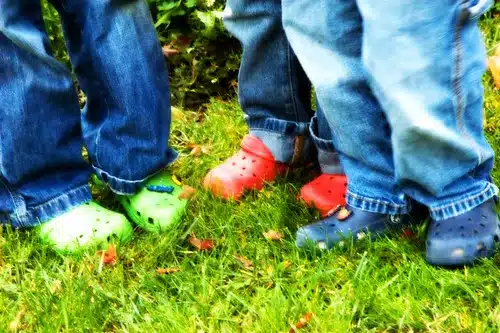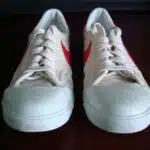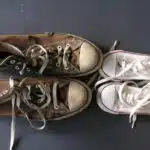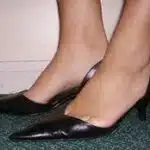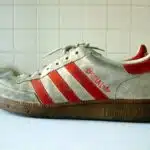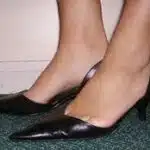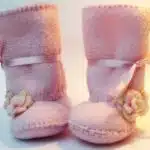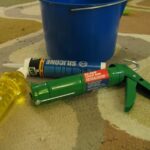For many people, Crocs are a go-to footwear option for everyday wear. The versatile and comfortable design of these shoes makes them a popular choice for gardeners, beachgoers, and healthcare professionals. However, with frequent use comes the need for cleaning and maintenance to ensure the longevity of your Crocs. In this article, we will provide you with three simple steps to clean your Crocs effectively and keep them looking as good as new.
As a footwear care expert, I understand the importance of maintaining your shoes to extend their lifespan. While Crocs are known for their durability and resistance to water and stains, they are not immune to dirt buildup and odor over time. By following our three-step cleaning process, you can easily remove any grime or discoloration from your Crocs while also eliminating any unpleasant smells. With just a few minutes of effort, you can keep your favorite pair of Crocs in top condition for years to come.
Why Cleaning Your Crocs Is Important
Properly maintaining and cleaning your Crocs is not only important for hygiene purposes, but also for the longevity of your footwear. As a footwear care expert, it is crucial to emphasize how neglecting to clean your shoes can result in the accumulation of dirt and bacteria that could lead to unpleasant odors or infections.
The importance of hygiene cannot be overstated when it comes to footwear care. Shoes are constantly exposed to various surfaces and environments, making them susceptible to collecting dirt, dust, and even harmful microorganisms. Wearing dirty shoes can cause health problems such as athlete’s foot or other skin infections. Therefore, taking the time to regularly clean your Crocs is essential in preventing any unwanted ailments from developing.
In addition to maintaining good hygiene practices, keeping your Crocs clean also plays a significant role in extending their lifespan. Dirt buildup on shoes can cause wear and tear on the material over time, resulting in cracks and discoloration. By implementing proper cleaning techniques into your footwear care routine, you can ensure that your Crocs remain looking like new for longer periods of time.
Materials Needed For Cleaning
- To effectively clean Crocs, a bucket of warm water and a mild detergent or soap should be used.
- For stubborn stains, a soft bristled brush can be employed.
- For extra cleaning power, a scrubbing pad and either baking soda, vinegar, white vinegar, bleach, baking powder, hydrogen peroxide, ammonia, rubbing alcohol, or dish detergent can be added to the cleaning solution.
- For optimal cleaning results, it is important to use the appropriate cleaning material depending on the type of stain and its severity.
- It is also important to keep all cleaning materials out of reach of children, as some substances can be hazardous.
- Additionally, it is important to ensure that all cleaning materials are thoroughly washed off the Crocs before allowing them to air dry.
Bucket
A bucket is one of the essential materials you will need when cleaning your Crocs. It provides a convenient and efficient way to mix and apply cleaning solutions to your shoes. Cleaning techniques vary depending on the type of dirt or stain present, but having a bucket at hand can make the process much easier.
When selecting a bucket for cleaning your Crocs, consider its size and material. A medium-sized plastic bucket that can hold at least a gallon of water is ideal. Plastic buckets are generally lightweight, durable, and easy to clean. DIY cleaning solutions such as vinegar and baking soda can be safely mixed in plastic buckets as they are chemical-resistant.
To use the bucket for cleaning your Crocs, fill it with warm water and add your preferred cleaning solution. Dip a soft-bristled brush or sponge into the solution and gently scrub the surface of your Crocs, paying special attention to areas with stubborn stains or dirt buildup. Rinse thoroughly with clean water and allow them to air dry in a well-ventilated area.
In conclusion, using a bucket for cleaning your Crocs is an effective way to get rid of dirt, stains, and odors from your favorite footwear. By following these simple steps, you can keep your Crocs looking clean and fresh for longer periods without spending too much time or money on professional cleaners. So don’t hesitate to grab that trusty bucket next time you decide to give your Crocs some TLC!
Warm Water
When it comes to cleaning your Crocs, warm water is one of the most essential materials you will need. It provides a multitude of benefits that can help in removing dirt and stains from your shoes effectively. Warm water can help break down dirt and grime, making it easier to loosen and remove them from the surface of your Crocs. Additionally, warm water can also help sanitize your shoes by killing bacteria and germs that may cause odors.
There are different uses for warm water when cleaning your Crocs. You can use it on its own or mix it with other cleaning solutions such as detergent or vinegar. Using warm water alone can be effective for simple cleaning tasks, while mixing it with other solutions can provide extra strength in removing tough stains or odors. However, be cautious not to use hot water as it may damage the material of your Crocs.
To incorporate warm water into your Crocs cleaning routine, fill up a bucket with warm water and add any desired cleaning solution. Dip a soft-bristled brush or sponge into the solution and gently scrub the surface of your shoes, focusing on areas with heavy dirt buildup or stains. Rinse thoroughly with clean water and allow them to air dry in a well-ventilated area. With this method, you’re sure to have cleaner and fresher-looking Crocs in no time!
Soap
Moving on to the next material needed for cleaning your Crocs, we have soap. Using natural soap can be a great addition to your Crocs cleaning routine as it is gentle on the material and won’t cause any damage or discoloration. It can also effectively remove dirt, grime, and odors from your shoes without leaving any residue.
When it comes to choosing the best soap brands for Crocs, there are a few things to keep in mind. Look for brands that use natural ingredients and avoid harsh chemicals that may cause harm to the material. Additionally, choose a soap that is specifically designed for footwear care to ensure its effectiveness in cleaning and maintaining the quality of your Crocs.
To use soap in cleaning your Crocs, mix a small amount of natural soap with warm water in a bucket. Dip a soft-bristled brush or sponge into the solution and gently scrub the surface of your shoes, paying attention to areas with heavy buildup or stains. Rinse thoroughly with clean water and allow them to air dry in a well-ventilated area. With this method, you can ensure that your Crocs are not only clean but also maintained properly for long-lasting use.
Step 1: Remove Dirt And Debris
After gathering the necessary materials for cleaning your Crocs, it is time to move on to the actual cleaning techniques. It is essential to remember that improperly cleaning your Crocs can lead to permanent damage and unwanted wear and tear. Therefore, it is crucial to follow the proper steps in cleaning them.
Firstly, before soaking your Crocs, remove any dirt or debris that may be stuck on them. To do this, use a soft-bristled brush or a dry cloth to gently remove any visible dirt or debris. You may also use a toothbrush in hard-to-reach areas. By doing so, you are ensuring that no abrasive material will be present during the actual cleaning process, preventing damage.
Secondly, after removing any dirt and debris from your Crocs, soak them in warm water for around 10-15 minutes. This step will help loosen up any remaining dirt and stains that may not have been removed during the first step. However, make sure not to use hot water as this may cause damage to the material of your Crocs.
Lastly, after soaking your Crocs in warm water for at least 10-15 minutes, rinse them thoroughly with clean water until there are no more soap suds left on them. Remember not to scrub too hard when rinsing as this may also cause damage. Instead, gently rub off any remaining dirt with your fingers while rinsing with water.
By following these simple steps of removing dirt and debris before soaking and then rinsing thoroughly after soaking with gentle rubbing motions instead of hard scrubbing ones, you can successfully clean your Crocs without causing any damage. The next step will be focusing on how you can properly apply soap and work through problem areas while still keeping your shoes safe from harm during the cleaning process.
Step 2: Soak Your Crocs
To effectively clean your crocs, the second step is to soak them in a cleaning solution. Soaking is an essential technique that helps to break down dirt and grime, making it easier to scrub away. There are different soaking techniques you can use depending on the type of crocs you have and the level of dirt and stains.
For regular crocs made of rubber or foam materials, a warm water soak with mild soap or detergent would suffice. Fill a basin or sink with warm water and add a few drops of liquid detergent or mild soap. Mix the solution thoroughly before immersing your crocs in it for about 30 minutes. This will help to loosen up any dirt or stains on the surface.
For more stubborn stains, you may need to use stronger cleaning solutions like vinegar or bleach. However, be careful when using these chemicals as they may damage your crocs if not used correctly. A diluted mixture of one part vinegar and three parts water can be used for soaking tough stains. Likewise, a tablespoon of bleach mixed with a gallon of water can also be used for soaking white-colored crocs.
In summary, soaking is an essential step in cleaning your crocs as it helps to loosen up dirt and grime before scrubbing them off. There are different soaking techniques you can use depending on the level of dirt and types of materials used in making your crocs. With these soaking techniques at your disposal, you can now proceed to the next step of scrubbing and rinsing your crocs until they are sparkling clean once again!
Step 3: Scrub And Rinse
After soaking your Crocs, it’s time to move on to the next crucial step in the cleaning process. Scrubbing your shoes with the right technique is key to achieving a spotless finish. Start by using a soft-bristled brush or sponge, and gently scrub the surface of your Crocs in a circular motion. Avoid using harsh scrubbers like steel wool or abrasive pads that can damage the material.
When it comes to cleaning solutions, there are several options you can choose from depending on what works best for you. Here are three popular cleaning solutions that are effective in removing dirt and grime from Crocs:
- Mild soap and water: Mix warm water and gentle soap in a bowl, dip your brush or sponge into the solution, and gently scrub your Crocs.
- Vinegar solution: Mix equal parts of water and vinegar in a bowl, dip your brush or sponge into the mixture, and gently scrub your shoes.
- Baking soda paste: Mix baking soda with enough water to make a thick paste, apply it onto your Crocs using your brush or sponge, let it sit for 15 minutes, then rinse off with clean water.
By using any of these three cleaning solutions coupled with proper scrubbing techniques will leave your Crocs looking brand new.
For tough stains that won’t come off easily, consider using a magic eraser. These versatile sponges work wonders on tough stains like scuff marks and stubborn dirt build-up. Simply wet the magic eraser and gently rub it onto the stained area until the stain fades away. Be sure to rinse off any residue left behind after use as this can cause discoloration over time when exposed to sunlight.
Using A Magic Eraser For Tough Stains
Using Magic Eraser for Tough Stains
When it comes to cleaning your Crocs, you may find that some stains are more challenging to remove than others. One tool that can help with tough stains is a Magic Eraser. This cleaning tool is made of melamine foam and works by using its micro-abrasive properties to scrub away dirt and grime.
To use a Magic Eraser on your Crocs, start by wetting the eraser with water. Then, gently rub the eraser over the area with the tough stain. You may need to apply some pressure to get the desired result. However, be careful not to rub too hard as this can damage the material of your Crocs.
In addition to using a Magic Eraser, there are other deep cleaning techniques you can try if you have stubborn stains on your Crocs. One option is to make a paste out of baking soda and water and apply it directly to the stain. Let the paste sit for a few minutes before rinsing it off with water. Another option is to mix equal parts vinegar and water in a spray bottle and spray the mixture onto the stain. Let it sit for a few minutes before wiping it away with a cloth.
| Deep Cleaning Techniques | How-to |
|---|---|
| Baking soda paste | Mix baking soda and water into a paste, apply directly on stain, let sit for few minutes then rinse off with water |
| Vinegar solution | Mix equal parts vinegar and water in spray bottle, spray onto stain, let sit for few minutes then wipe away with cloth |
With these deep cleaning techniques at your disposal, you can keep your Crocs looking their best even when faced with tough stains. In the next section, we’ll discuss tips for preventing odor from building up in your Crocs over time.
Tips For Preventing Odor
Preventing Odor is an important aspect of long term maintenance for your Crocs. Here are some tips to keep them smelling fresh and clean. Firstly, always make sure your feet are clean and dry before putting on your Crocs. Moisture is a breeding ground for bacteria, which can cause odor.
Secondly, regularly wash your Crocs with soap and water to remove any dirt or sweat that may have accumulated. It’s recommended to do this at least once a week if you wear them frequently. Using a soft-bristled brush will help to get into the crevices of the shoes, ensuring they’re thoroughly cleaned.
Lastly, consider using odor-eliminating products such as baking soda or activated charcoal inserts in your Crocs when you’re not wearing them. These products absorb moisture and neutralize odors, helping to prevent any unpleasant smells from developing in the shoes over time. By following these simple tips, you can easily prevent odor from becoming a problem in your beloved pair of Crocs.
To ensure that your Crocs remain in good condition, it’s important to dry them properly after washing or wearing them in wet conditions. Leaving them damp can cause mold or mildew growth, which can be difficult to remove later on. In the next section, we’ll discuss some tips for drying out your Crocs effectively without damaging their material or structure.
Drying Your Crocs
To prevent odors from plaguing your Crocs, it is essential to take good care of them. While cleaning is crucial, so is the process of drying them. Air drying is by far the best way to dry your Crocs after washing them. You can also use a hairdryer if you’re in a hurry, but you need to make sure that the heat setting isn’t too high. Let’s explore why air drying is better than using a hairdryer.
Benefits of letting your Crocs dry naturally are multiple. Firstly, it eliminates any chances of damaging the material or shrinking its size because of excess heat. Secondly, air drying helps to reduce the spread of bacteria and fungus on your shoes as it allows for proper ventilation and moisture evaporation. Thirdly, it keeps your Crocs looking new for longer as there are no risks of color fading or fabric damage caused by excessive heat exposure.
In conclusion, taking care of your Crocs involves not only cleaning them but also ensuring they dry properly after washing. The best method for drying them is leaving them out to air dry naturally, which has numerous benefits over using a hairdryer or other heating methods. In the next section, we will discuss some common mistakes people make when cleaning their Crocs and how to avoid them.
Avoiding Common Cleaning Mistakes
Coincidentally, cleaning crocs is not as easy as one might think. One of the biggest mistakes people make when cleaning their crocs is using harsh chemicals or abrasive materials, which can damage the material and shorten the lifespan of the footwear. Another common mistake is failing to properly dry the crocs after cleaning them, leading to a buildup of moisture and bacteria.
To avoid these common cleaning mistakes, there are some tips for effective cleaning that every footwear owner should follow. Firstly, always check the care label on your crocs before starting to clean them. Different materials require different types of cleaning methods, so it’s important to know what you’re dealing with. Secondly, use gentle cleaners and soft-bristled brushes to clean your crocs, avoiding anything too harsh or abrasive that could cause damage. Finally, make sure you dry your crocs thoroughly after washing them by leaving them in a well-ventilated area or using a fan.
By following these simple tips for effective cleaning, you’ll be able to keep your crocs looking good as new for longer. However, it’s also important to consider how often you should be cleaning them in order to maintain their quality and prolong their lifespan. In the next section, we’ll discuss how frequently you should be washing your crocs in order to keep them in top condition.
How Often Should You Clean Your Crocs?
Having discussed common cleaning mistakes, it is now important to consider how often you should clean your Crocs. The frequency of cleaning will depend on how often you wear them and the conditions they are exposed to. If you wear your Crocs every day in dirty or wet environments, then you should clean them more frequently than if you only wear them occasionally.
The best methods for cleaning your Crocs involve using mild soap and water, or a specialized cleaner. It is important to avoid using harsh chemicals or abrasive materials that could damage the material. You can use a soft-bristled brush or cloth to gently scrub away any dirt or stains. After cleaning, allow your Crocs to air dry completely before wearing them again.
In addition to traditional cleaning methods, there are alternatives that can help keep your Crocs looking fresh and clean. One option is to use a UV shoe sanitizer, which uses ultraviolet light to kill bacteria and eliminate odors. Another alternative is to use odor-neutralizing sprays or inserts that can absorb moisture and odor. Whatever method you choose, it is important to follow the manufacturer’s recommendations and take good care of your Crocs for long-lasting wear.
Alternatives To Traditional Cleaning Methods
Crocs are an essential part of daily footwear for many people due to their comfort and versatility. However, traditional cleaning methods can sometimes be harsh on the material or not eco-friendly. Therefore, it is important to consider alternatives that are both effective and sustainable.
One eco-friendly option is to use DIY cleaning solutions made with natural ingredients such as vinegar, baking soda, and lemon juice. These substances have powerful cleaning properties that can remove dirt and stains without damaging the crocs’ material. For example, a mixture of baking soda and water can be applied to the surface with a soft brush or cloth, left for a few minutes, and then rinsed off with water.
Another alternative is to use specialized eco-friendly products that are designed specifically for crocs or other types of footwear. These products often contain natural ingredients such as coconut oil or plant-based enzymes that can effectively clean and restore the shoes while also being gentle on the environment. Some brands even offer refillable containers or recyclable packaging options to reduce waste.
In addition to using eco-friendly options, it’s important to also consider the specific type of crocs being cleaned. Different materials may require different cleaning methods or products. For example, leather crocs should be treated with a leather cleaner and conditioner to maintain their quality over time. Similarly, crocs with fur linings should be brushed gently with a soft brush to avoid damaging the fur fibers.
Transition: Now that we’ve explored some alternatives to traditional cleaning methods in general, let’s take a closer look at how to clean specific types of crocs for optimal results.
Cleaning Specific Types Of Crocs
As mentioned in the previous section, traditional cleaning methods may not always be suitable for cleaning certain types of footwear. When it comes to crocs, there are specific cleaning techniques you should follow to ensure that your shoes remain in good condition. This is especially important when it comes to kids’ crocs or those used for outdoor activities as they tend to get dirtier faster.
Cleaning crocs for kids requires extra care and attention to detail. Kids tend to play outdoors and get their shoes dirty more often than adults do. To clean their crocs, start by removing any loose dirt or debris with a soft-bristled brush or damp cloth. Next, mix warm water with a mild detergent and use a sponge or cloth to gently scrub the surface of the shoe. Rinse thoroughly and let them air dry.
For those who use their crocs for outdoor activities such as hiking or gardening, it’s important to clean them regularly to avoid any buildup of dirt, mud, or debris. Begin by rinsing off any excess dirt with water before using a soft-bristled brush or cloth soaked in warm soapy water to clean the surface of the shoe. Rinse thoroughly and let them air dry away from direct sunlight.
Properly caring for your crocs not only helps them last longer but also keeps them looking their best. In addition to regular cleaning, it’s essential to store your crocs properly when not in use. In the next section, we’ll discuss some tips on how to store your crocs correctly and avoid any damage that may occur if they’re not stored correctly.
Storing Your Crocs Properly
Proper storage is an essential part of long term care for your Crocs. It is crucial to keep them in a clean and dry place to avoid any possible damage or deformation. Consider the following tips for storing your Crocs properly:
Keep them away from direct sunlight: Direct sunlight can cause the color of your Crocs to fade over time. To preserve the original color, it’s best to store them in a cool and dark place.
Use shoe trees or crumpled paper: Stuffing your Crocs with shoe trees or crumpled paper will help maintain their shape and prevent them from getting squished or misshapen.
Store them in a breathable bag: A breathable bag will help protect your Crocs from dust and dirt while still allowing air circulation, which will prevent any musty odors from accumulating.
Following these simple steps will ensure that your Crocs remain in good condition and can be worn for years to come.
When it comes to footwear care, proper storage is just one aspect of maintaining the longevity of your shoes. In the next section, we’ll discuss how to know when it’s time to replace your Crocs and what signs to look out for.
When To Replace Your Crocs
- Signs of wear and tear such as fading, splitting, or cracking of the material can indicate it is time to replace your Crocs.
- Additionally, a buildup of odors caused by perspiration and dirt can be an indication that your Crocs are due for a replacement.
- Cleaning your Crocs on a regular basis can help extend their life, however, some materials are more prone to damage or deterioration than others.
- Ultimately, the lifespan of your Crocs will depend on the amount of wear and tear they experience, as well as the level of care and maintenance given to them.
Signs Of Wear And Tear
As a footwear care expert, it is important to know when it is time to replace your Crocs. Signs of wear and tear can indicate that the shoes have reached the end of their lifespan. Some common signs include holes or tears in the material, worn-out soles, and broken straps. These issues not only affect the appearance of the shoe but can also compromise its functionality.
If your Crocs are showing signs of wear and tear, repairing them may not be an option. While some minor issues like loose straps or faded colors can be fixed with basic DIY techniques, more significant damage requires replacement. Continuing to wear damaged shoes can lead to discomfort and even injury. It is best to retire old Crocs and invest in a new pair for optimal performance.
Replacing Crocs may seem like an unnecessary expense, but it is crucial for maintaining foot health and comfort. Over time, Crocs lose their original shape and support which can cause strain on the feet and legs. Additionally, worn-out shoes may harbor bacteria or fungus causing unpleasant odors or infections. By replacing your Crocs when necessary, you ensure that your feet are properly supported and protected from harmful elements.
In conclusion, recognizing signs of wear and tear in your Crocs is essential for maintaining foot health and comfort. Repairing minor damage can extend the life of the shoe but replacing them altogether is often necessary for optimal functionality. As a footwear care expert, it is important to educate yourself on these signs in order to provide excellent customer service to those seeking advice on their footwear needs.
Odor Build Up
Another important factor to consider when deciding when to replace your Crocs is the presence of odor build-up. Over time, bacteria and fungus can accumulate in the shoes, causing unpleasant smells and even infections. While some minor odors can be eliminated with basic cleaning techniques, more significant odor problems may require replacement of the shoes altogether.
To prevent smells from building up in your Crocs, it is essential to take proper care of them. Regular cleaning and airing out of the shoes can help reduce bacterial growth and prevent unpleasant odors from developing. Additionally, using specialized odor-eliminating products or inserts can help keep your Crocs smelling fresh and clean.
If your Crocs are already experiencing significant odor build-up that cannot be remedied with basic cleaning techniques or specialty products, it may be time to invest in a new pair. Continuing to wear smelly shoes not only affects their appearance but also poses a health risk to your feet. By recognizing the signs of odor build-up and taking steps to prevent it, you can prolong the life of your Crocs and maintain optimal foot health.
Final Thoughts On Cleaning Crocs
After determining when to replace your Crocs, it is essential to keep them clean regularly. Clean footwear has numerous benefits, including improved hygiene and increased durability. Proper maintenance helps prevent the accumulation of dirt and bacteria that can cause unpleasant odors and discolorations on your shoes. It is also crucial to note that cleaning Crocs isn’t a time-consuming task; it takes only a few minutes.
Neglecting the maintenance of your Crocs can have long-term effects on their quality and performance. Dirt buildup can cause cracks and holes in the shoe’s material, leading to discomfort while wearing them. Additionally, neglecting proper maintenance can lead to fungal infections, which can be difficult to treat. These infections are caused by bacteria that thrive in dirty shoes, leading to skin irritation and odor.
In conclusion, keeping your Crocs clean is an essential part of maintaining their quality and durability. Regular cleaning not only improves hygiene but also prevents long-term damage caused by neglecting proper care. As a footwear care expert, I recommend investing in high-quality cleaning products for better results. Remember, a little effort goes a long way when it comes to maintaining your favorite pair of Crocs!
Conclusion
Cleaning your Crocs is essential to maintain their appearance and extend their lifespan. Neglecting to clean them can lead to the buildup of dirt, sweat, and bacteria, which can cause unpleasant odors and even infections. Fortunately, cleaning your Crocs is a simple process that only requires a few household items.
To get started, gather a soft-bristled brush or sponge, mild soap or detergent, and warm water. Begin by removing any visible dirt or debris from your Crocs using the brush or sponge. Next, soak your Crocs in warm water mixed with a small amount of soap or detergent for 10-15 minutes.
After soaking, use the brush or sponge to scrub away any remaining dirt or stains. Rinse thoroughly with clean water and allow them to air dry. Be sure not to expose them to direct sunlight or heat sources as this may damage the material.
Different types of Crocs may require specific cleaning methods such as using baking soda for odor removal on Crocs made with foam material. Additionally, storing your Crocs in a cool, dry place will help prevent mold growth and maintain their shape.
Remember that while cleaning your Crocs regularly can prolong their life span, it’s important to know when it’s time to replace them altogether. Signs that it’s time for new Crocs include deep cracks in the material or significant wear and tear.
In conclusion, taking care of your footwear is an essential part of maintaining hygiene and extending its lifespan. Cleaning your Crocs regularly ensures they stay fresh and free from harmful bacteria buildup that could affect your health. Follow these simple steps provided by our footwear care experts so you can enjoy wearing your favorite pair of comfortable shoes for years to come!
Image Credits
- “Crocs” by St0rmz (featured)

